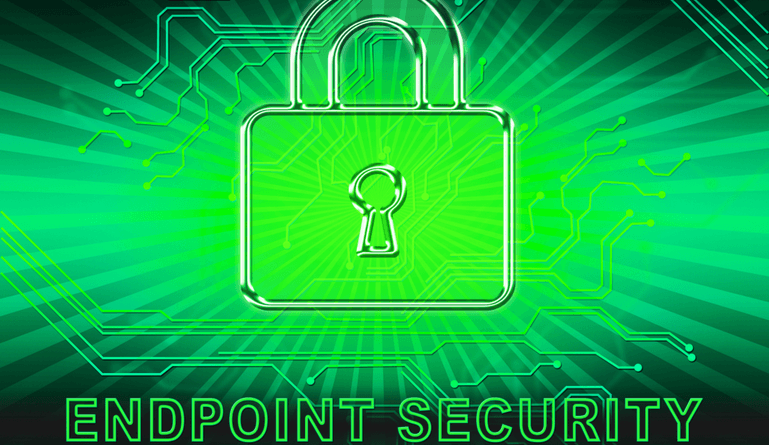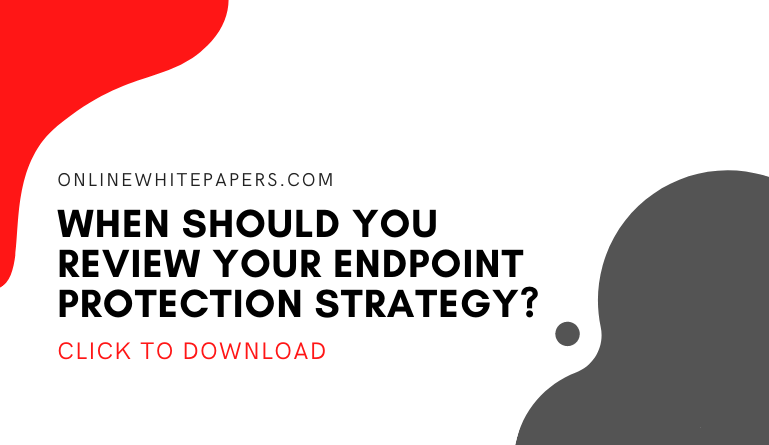To put it simply, endpoint security protects the commonly used digital devices mentioned above (smartphones, laptops, and desktop computers) from weaknesses from within the software that could lead to hackers, viruses, and malware entering into a system’s internal data storage where sensitive information is kept and accessing it for nefarious purposes.
What is an Endpoint?
Almost everybody has one, but they might not know what it is. Think about the digital devices that you use on a daily basis. A desktop computer? Probably. A tablet or laptop computer? Most likely. A smartphone or mobile device? Definitely. These devices are what is referred to in the network security space as endpoints.
“Endpoints serve as points of access to an enterprise network and create points of entry that can be exploited by malicious actors,” (Forcepoint.com). Laptops, smartphones, and desktops are used widely by both consumers and businesses alike. But, for businesses having a level of protection from hackers looking to gain access to sensitive information about their customers and the company itself is of top priority.
Why is Endpoint Security Important?
With the rise of work from home opportunities, more and more employees are using their own devices to complete work tasks. Companies not only have to worry about devices within the office being vulnerable to online attacks they also have to take into consideration their employees’ devices used outside of their facilities connected to their system as well.
With the streamlining of multiple sources of technology that can gain access to a single platform, businesses must ensure that their systems are a safe stronghold against outside attacks by vetting endpoints.
How Does It Work?
This digital safety strategy protects sensitive information and operations related to the endpoint tools that can gain access to an enterprise’s internal system. Most safety precautionary programs focus on the system itself and focus on keeping an eye out for possible cyberattacks from the inside, but endpoint security focuses on possible breaches from the outside via outside devices also known as endpoints
Different Types of Endpoint Security
-
Endpoint protection platform (EPP):
This way of conducting endpoint security functions by analyzing every single file that comes into a business’ internal system. Through a cloud-based endpoint system, an endpoint protection platform can look over the information stored inside to cultivate an expanding resource of data where potential attacks could occur.
This allows for business managers to have a main area console, which is built into a business’ operational system and lets online security experts handle safety measures for every endpoint off-site.
From there, a business’ system becomes familiarized with every endpoint that it comes into contact with and can then apply upgrades to endpoint devices at any time, verify log-ins via individual endpoints, and enforce company procedures from a single place. EPPs can also authorize app use by determining which ones are dangerous or safe to use via encryption (this curbs the misplacement of information). Once an EPP is put into use, the platform can swiftly catch security breaches like malware.
-
Endpoint detection and remediation (EDR):
The purpose of this endpoint security function is to have the ability to catch more high-level breaches, like no-file malware, zero-day strikes, and miscellaneous attacks. With non-stop management of a business’ internal systems, EDR endpoint security can provide clearer insight and diverse defense choices.
-
Extended detection and response (XDR):
This type of endpoint security operates as a software-as-a-service that is offered to businesses via a provider. XDR functions to catch breaches and vulnerabilities to a system’s safety capabilities and handles threats by streamlining various safety tools into a smooth-running system by combining all permitted elements.
( Also Read: Benefits of Cloud-Based Endpoint Security )
Core Functionalities of Endpoint Protection
If you are looking for an endpoint protection solution that provides constant breach prevention, consider these four critical functional aspects:
-
Prevention
If we look at the traditional anti-virus systems, they are not completely effective as they can only detect less than half of the attacks. NGAV known as Next Generation Anti-Virus bridges this deficiency by deploying AI and machine learning in the endpoint protection systems. This way they can identify and eliminate threats that are arising from file hashtags, suspicious links, and IP addresses.
-
Detection
Prevention is just one part of the core function. Beyond prevention, EPP platforms should also be able to detect these attacks if they pass through the company firewall and enter the premises.
-
Managed Threat Hunting
Automation is not the only solution. There are some areas where professional expertise is needed to detect cyber attacks of the modern era. Managed threat hunting is a task conducted by a team of core security professionals to detect and eliminate threats.
-
Integration of Threat Intelligence
More than being reactive, businesses need to be proactive. Hence, companies adopt advanced persistent threat models to be way ahead of the attackers and eliminate even if there is a whiff of such attacks.
Elements Of Endpoint Security
Endpoint security programs have several important elements:
- Artificially intelligent categorization to catch zero-day strikes as it happens
- Top-level antivirus and antimalware security to prevent, catch, and fix malware amongst numerous endpoint tools and networks
- Dynamic online security to guarantee secure perusing of the web
- Information labeling and information misplacement prevention to curb the loss of sensitive information and hacking
- Provides a united firewall tool to prevent dangerous attacks on an operational system
- The email entryway stops phishing and manipulation tactics from being directed toward workers
- Pragmatic threat diagnostics to give managers a way to swiftly pinpoint breaches
- Expert attack prevention to protect against accidental and intentional actions
- A singularly controlled endpoint monitoring program to enhance discernment capabilities and streamline system functions
- Endpoint, digital mail, and disk encoding to stop data breaching
Benefits of Endpoint Security
-
Collaboration between safety measures and administrators
Digital security and administration are often treated as different sectors of a business’ operation. But, when an outside cyberattack threatens the data of an organization and its workers, the security and administrative team can come together to combat the threat. This alliance not only makes the internal systems safer but it strengthens the network of a company as a whole.
-
Protects against a vital and direct threat
No matter if it is malware, zero-day strikes, or a variety of miscellaneous attacks, having endpoint security provides an all-around form of protection against potential breaches that attack from the outside. With how insightful and precise these safety measures are, problems can be pinpointed, located, analyzed, and foiled.
-
Find and fix safety vulnerabilities
Locate any weaknesses within a company’s internal operating system and fix potential problems that could lead to serious problems if not identified and left unchecked. It is more dangerous to not know that there is a problem than to know what is going on and not do anything about it. But it is advised to not handle security threats in this way and be proactive, not reactive.
-
Streamline management
Simplify oversight capabilities by having everything that a business would need (security, data management, and storage portal) in a single program specializing in endpoint security. Having these tools all in one place to access different operational needs gives the advantage and high ground to businesses in an era of increasing levels of remote work.
-
Guard your company’s name and reputation
Safeguard your good name as a business by being on top of everything that is going on outside of the internal operating system or network. By being well-known for being hawkish over sensitive company and employee information, word will spread about your business’ values around providing state-of-the-art safety measures and strategies. A business’s reputation can also be ruined from not being proactive and allowing online attacks to compromise their systems.
-
Stay ahead with Zero Trust
Anything that comes in contact with a business’ internal operational system or network, no matter if it is a work file or email, gets vetted and analyzed for potential cyberattacks and threats. This allows businesses to establish and keep control of their networks and makes it harder for outside attacks via endpoint devices to get into the system.
Endpoint Security Challenges
-
Devices of the Internet
As endpoint devices continue to evolve and become more advanced, they may carry over threats that utilize them for strikes and attacks against data systems. When devices are made they are either not equipped with digital security measures, have out-of-date safety capabilities, or are undetectable to endpoint security platforms due to being just introduced in the market.
-
New devices, new threats
As technology evolves, so do the malware and other compromising system threats. As mentioned earlier in this piece, some forms of malware do not even need files to enter a business’ data network (fileless or no-file malware).
-
This is a stick-up
Data thieves will often utilize ransomware to exploit businesses and federal institutions to gain access to sensitive information due to the lack of money, tools, and safety measures to defend against this particular type of threat.
-
Fixing and repairs
Patching or fixing up endpoint gateways can be a daunting task for members of the security department, especially since data thieves can switch up their attack methods just as quickly as patchwork is completed.
-
Trust no-thing or device
No matter the size of a business, the security of network systems must be a top priority to ensure the safety of the company, employee, and customer information stored within the system. This means vetting and analyzing every single device that comes into contact with the data.
What is Considered an Endpoint?
- Mobile devices
- Tablets
- Smartwatches
- Laptops
- ATMs
- Servers
- Medical devices
Printers
Difference Between Endpoint Security and Network Security?
Endpoint security focuses on the devices outside of a company network (i.e. mobile devices, desktops, and laptops) that can come into that company’s internal operating system and cause data breaches by bringing in a variety of security threats such as ransomware, malware, and data thieves.
Network security deals with the digital structures and tools created and utilized solely to maintain and safeguard the network itself from the inside. Through some of the factors of data security such as anonymity, having good values, concealment of information, and accessibility, network security keeps internal operations running smoothly and safely.
Why is Endpoint Security so Critical Today?
As mentioned earlier, with the rise of remote work opportunities more endpoint devices are being used to complete work tasks. While convenient to use on the go and at any time, endpoint devices present a variety of avenues for outside threats to enter into a business network and compromise important data of the company, its employees, and customers.
Final Thoughts
Looking back and recalling experiences completing my work tasks from my laptop, I can pinpoint when I sent an assignment to a high-level employee and they requested that I resend using a different platform. I was curious as to why I could not merely send my work from Google Docs through a shareable link. But, learning more about endpoint security and how attackers take advantage of outside devices to try to enter into company networks has brought some clarity to my past inquiry.






